Have you noticed caterpillars on your tomatoes? Then you probably are already concerned about the trouble they can cause.
You may have noticed chewed leaves or a hole straight through the tomato. Tomato caterpillars damage harvests and cause headaches for home gardeners.
There are several caterpillars that eat tomatoes. We have listed them here, so you can identify them, along with how to get rid of them, and prevent them.
Table of Contents
Caterpillars on Tomato Plants
If you are worried about tomato caterpillars, you will want to look at the top of your tomato plant for black or dark green droppings, which are left by the caterpillars as they feed on the leaves. Look under the leaves for the caterpillars. Sometimes some stems are missing leaves or the leaves are wilted and hanging.
When the caterpillars first invade your tomato plants, the foliage and fruits can be attacked. Younger caterpillars eat at the top surface of new leaves, as they increase in size, they make holes in the leaves. Some will tunnel into the tomatoes.
The caterpillars that eat tomatoes include:
1. Large Yellow Underwing Caterpillar
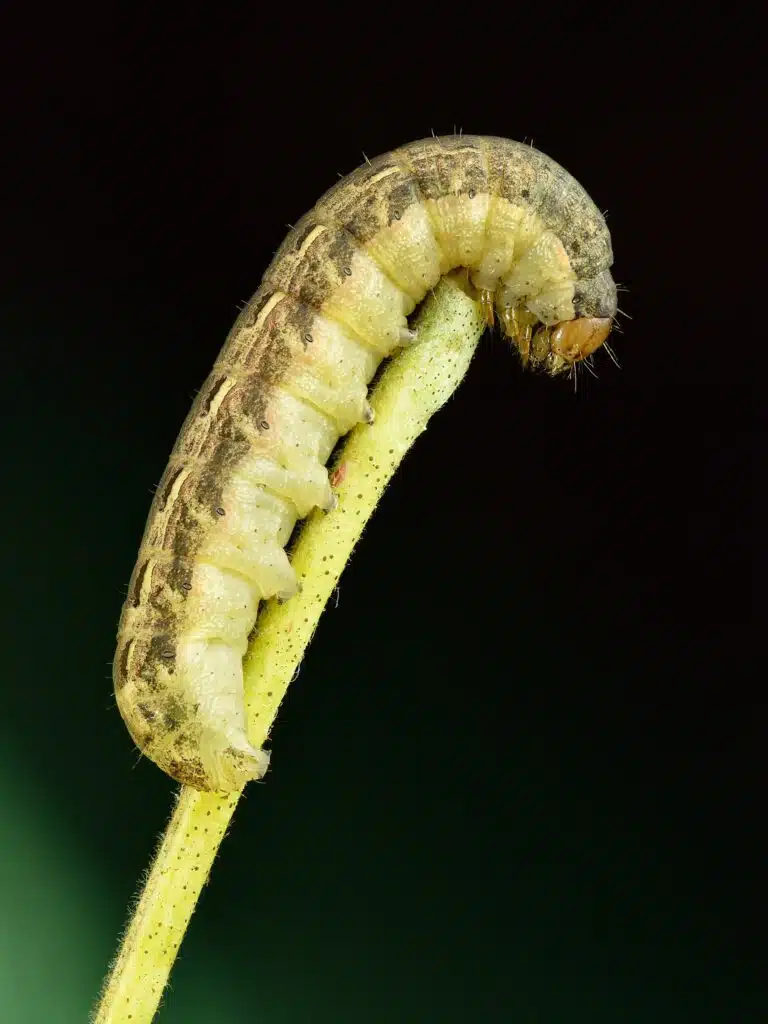
The Large Yellow Underwing (Noctua pronuba) is a moth, belonging to the Noctuidae family. The caterpillars are brown or green with two rows of black dashes on the back. They are also known as cutworms and cause damage to the base of tomato plants. They are known to sever the plant completely.
They are a serious garden pest that overwinters in the larva stage, feeding on the milder days during the winter months. These caterpillars can grow to 50mm in length.
2. Clover Cutworm
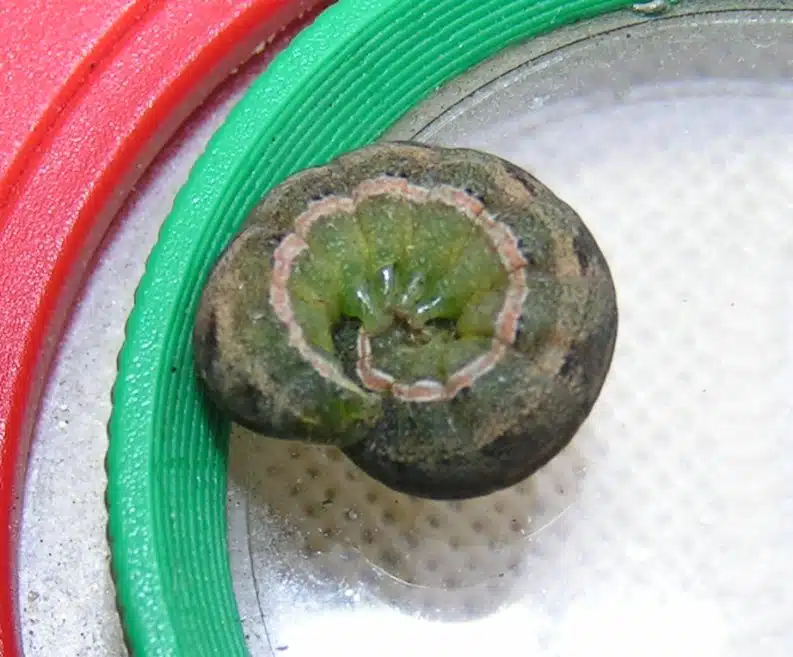
The Clover Cutworm (Hadula trifolii) is also known as the nutmeg, a moth belonging to the Noctuidae family. The caterpillars are brown or green with dark dots on the back, with pale lines that are wider. Some have yellow or red coloration.
The moth travels long distances and is a nocturnal moth. The caterpillars are known for being a pest to cultivated tomato crops.
3. Setaceous Hebrew Character Caterpillar
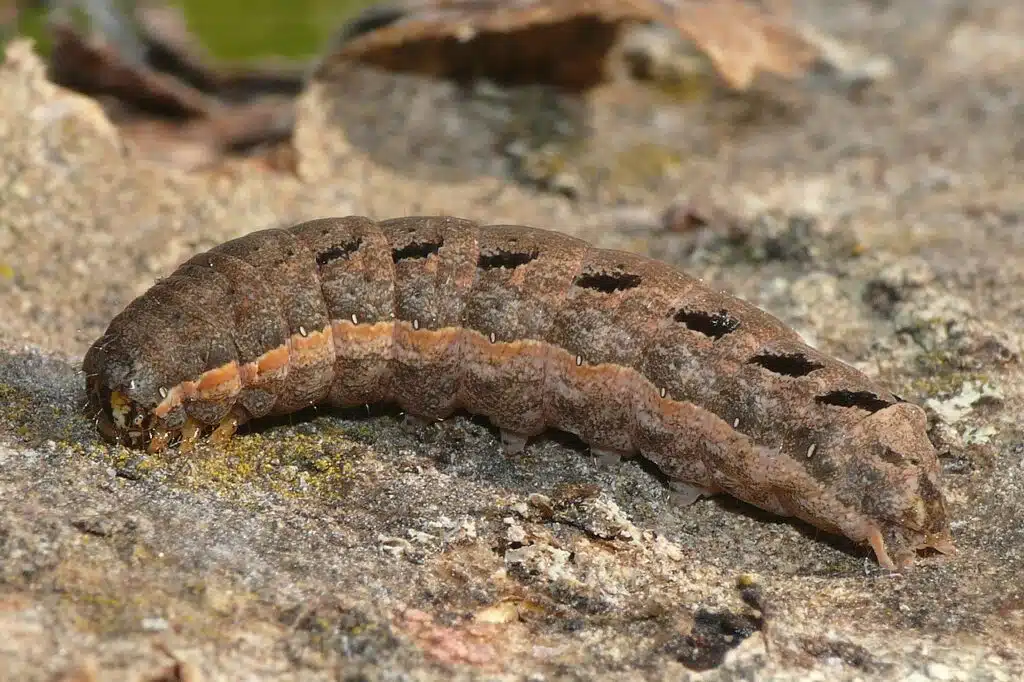
The Setaceous Hebrew Character (Xestia c-nigrum) is a moth belonging to the Noctuidae family. The caterpillars are red-brown or green with pale lines. The caterpillars feed on a variety of plants, spending their winter in the larva stage.
These caterpillars can be found in lowland habitats, including woodlands, marches, and gardens.
4. Tomato Hornworm
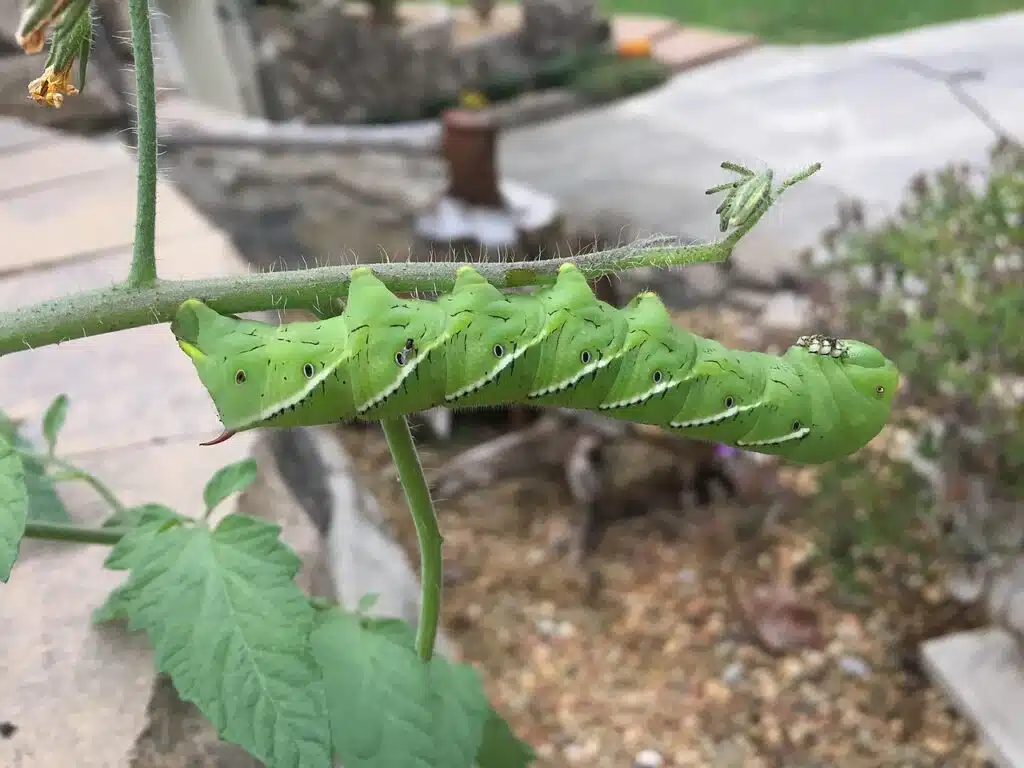
The Tomato Hornworm (Manduca quinquemaculata) is a common pest in gardens, feeding on tomatoes. As adults, they are large-bodied moths, often referred to as hawk moths. The hornworm has a V-shaped marking on the body in white-yellow. The horn is a protrusion from the final abdominal segment.
When they first hatch, they stay close to the leaf where the egg was laid. The caterpillar proceeds to feed on the leaf tissue before the first molt. The caterpillar remains close to the host plant until the fifth molt.
This caterpillar camouflages itself in the host plant leaves with a green body and black horn with V-shaped markings. When it’s time to pupate, the caterpillar creates an underground space, creating a dark and large pupa, which encases the developing adult moth.
The caterpillars are known to feed continuously on tomato plants, starting at the highest canopy of the plant. They can cause completely defoliate a plant if they are not removed effectively. They also feed on the developing fruit, specially cultivated tomatoes. The fruit that has been damaged by these caterpillars does not mature properly.
5. Tobacco Hornworm
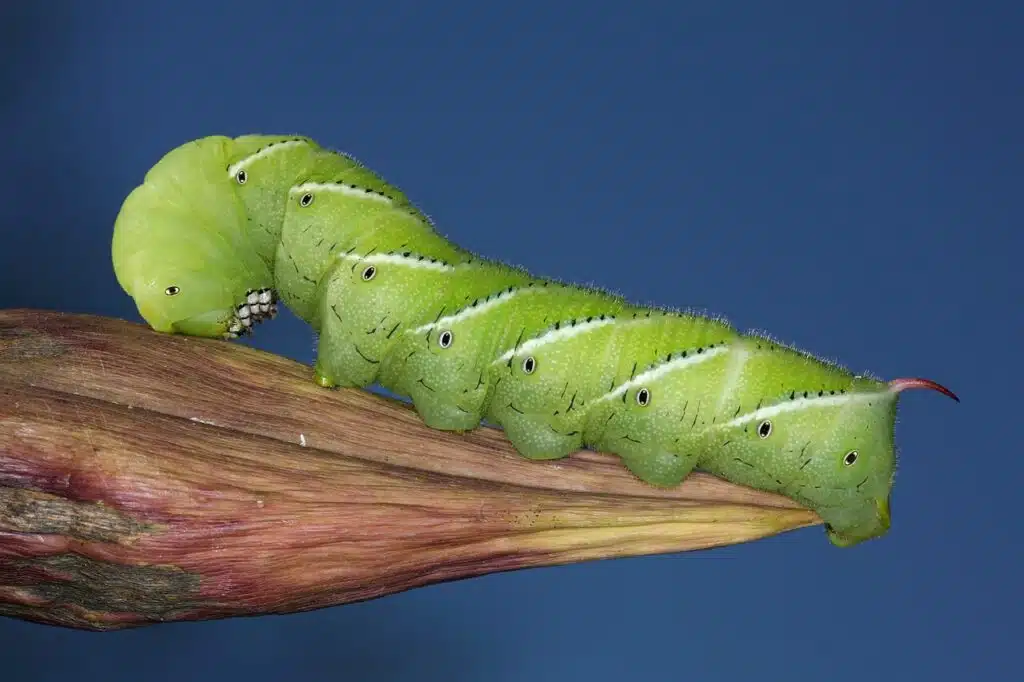
The Tobacco Hornworm (Manduca sexta) is known as the Goliath worm. Some children keep them as pets, but they are pests to farmers and gardeners. They are similar to the tomato hornworm, mentioned above, except the tobacco hornworm has seven white diagonal lines with black borders and red horns.
Tobacco hornworms have straight white lines, unlike the V-shaped lines of the tomato hornworm. The caterpillar is bright green and grows to 70mm in length. Each segment of the abdomen has a pair of legs.
The caterpillar feeds on plant foliage of tomato and tobacco plants. They also burrow underground to pupate.
6. Cotton Cutworm
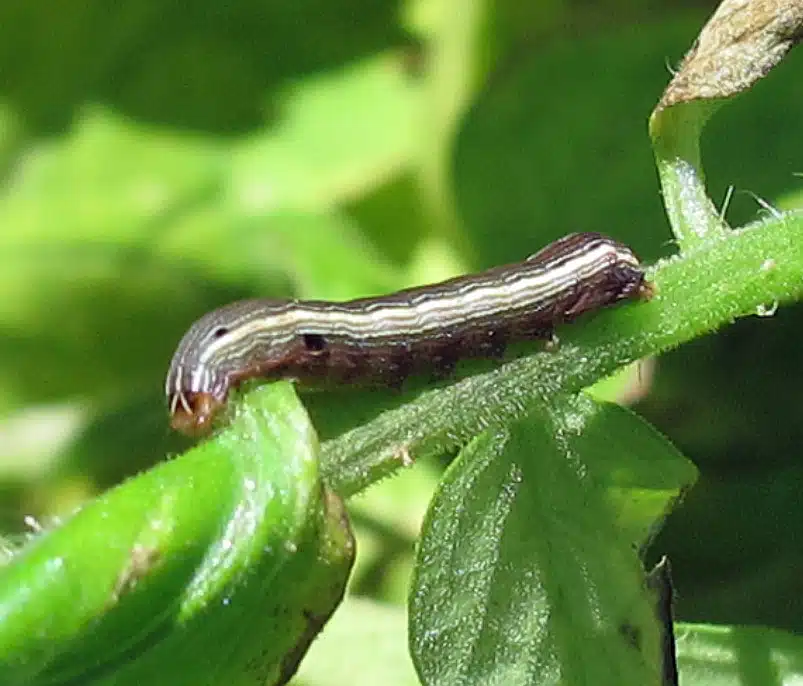
The Cotton Cutworm (Spodoptera ornithogalli) is common in the eastern United States. They are pests that are gregarious feeders. When they mature, they disperse by spinning silk, which is blown in the wind.
The caterpillars grow to 35mm in length with variable coloration. The mature caterpillar has a brown band on the back and a white line in the center. There are black triangular markings on each side with a white or yellow line below. The head has an inverted V on the face.
The caterpillar stage lasts for up to twenty days. When they are ready to pupate, they dig into the soil and create a thin cell of silk, which is red/brown. This is around 18mm in length. After eighteen days an adult moth emerges.
7. Beet Armyworm
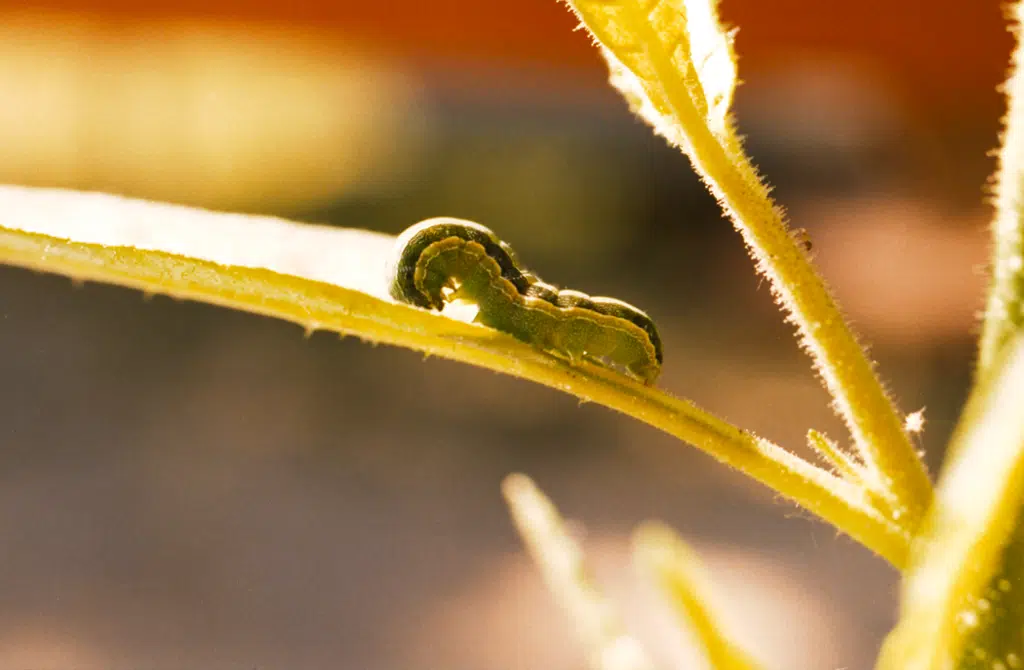
The Beet Armyworm (Spodoptera exigua) is a willow moth and a known agricultural pest. They are often called the asparagus fern caterpillar and are native to Asia. They have been introduced around the world.
The caterpillars are voracious. The caterpillars are pink/brown with black. As they age they become green-brown cutworms with dark stripes. They feed on the foliage and fruits of tomato bushes, often defoliating the entire plant.
Small caterpillars damage the leaves, leaving only the veins and epidermis. The larger caterpillars are known to burrow holes through the thick area of the tomato. They will attack the new growth and buds of the plants, stopping new leaves and vegetables from developing.
8. Fall Armyworm
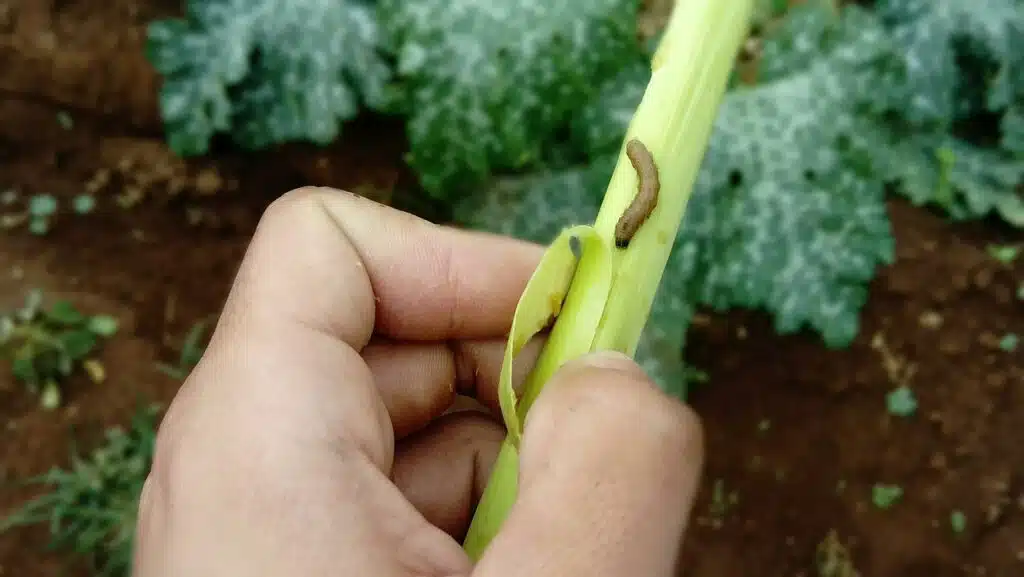
The Fall Armyworm (Spodoptera frugiperda) is an invasive species, regarded as a serious threat for destroying numerous crops and causing economic damage. The caterpillars go through six growth stages, each one the caterpillar changes in pattern and appearance.
The caterpillar stage lasts up to thirty days, depending on the temperature. Adult caterpillars are up to fifty-one millimeters in length. The final stage is the most destructive, as the caterpillars have developed large mouthparts.
The caterpillar will pupate underground for around thirty-seven days. They feed on grasses, corn, and tomatoes. This caterpillar is known to feed on up to eighty different plants.
9. Corn Earworm
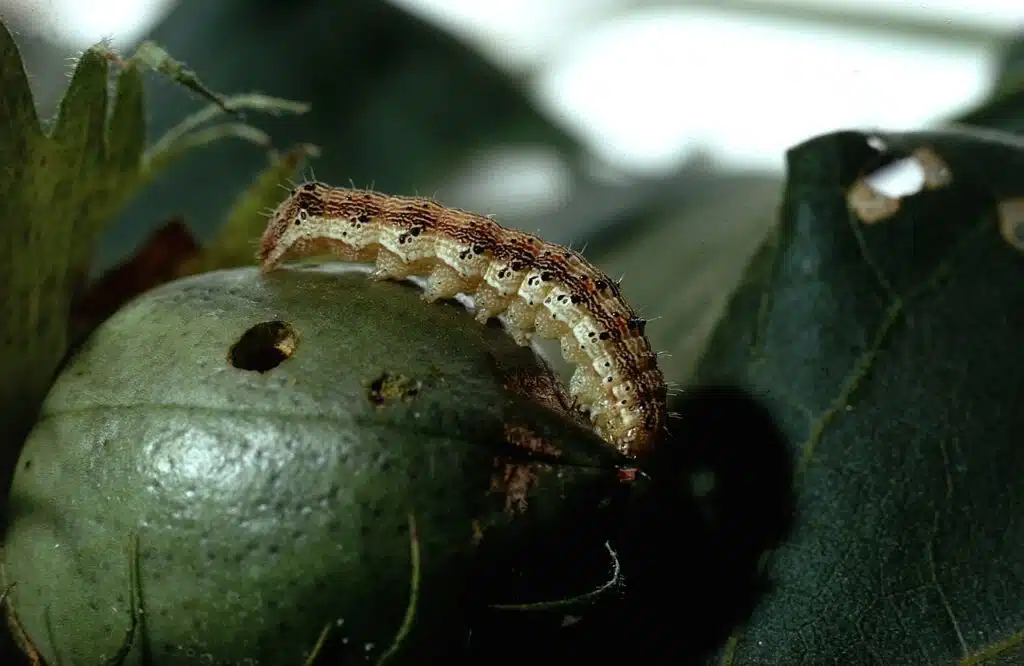
Corn Earworms (Helicoverpa zea) are common in North America. They survive far north and are highly dispersed. When the caterpillar first hatches, it wanders around the host plant in search of a suitable feeding site, which is usually the reproductive structure of the plant.
When the caterpillar is young, it will feed with other caterpillars, but as they mature, they become very aggressive and will kill and eat each other. Often only one mature caterpillar will be found on each plant.
These caterpillars vary in color, though they all have an orange to light brown head with a net-like pattern. They have black thoracic plates and the body is green, pink, yellow, black, or brown. There is a wide dark stripe on the back and light yellow or white stripes, just below the spiracles.
The caterpillar creates an underground chamber in the soil where it will pupate. The pupa is brown and around twenty-two millimeters in length. The pupal stage is thirteen days before an adult moth emerges.
10. Cabbage Looper Caterpillar
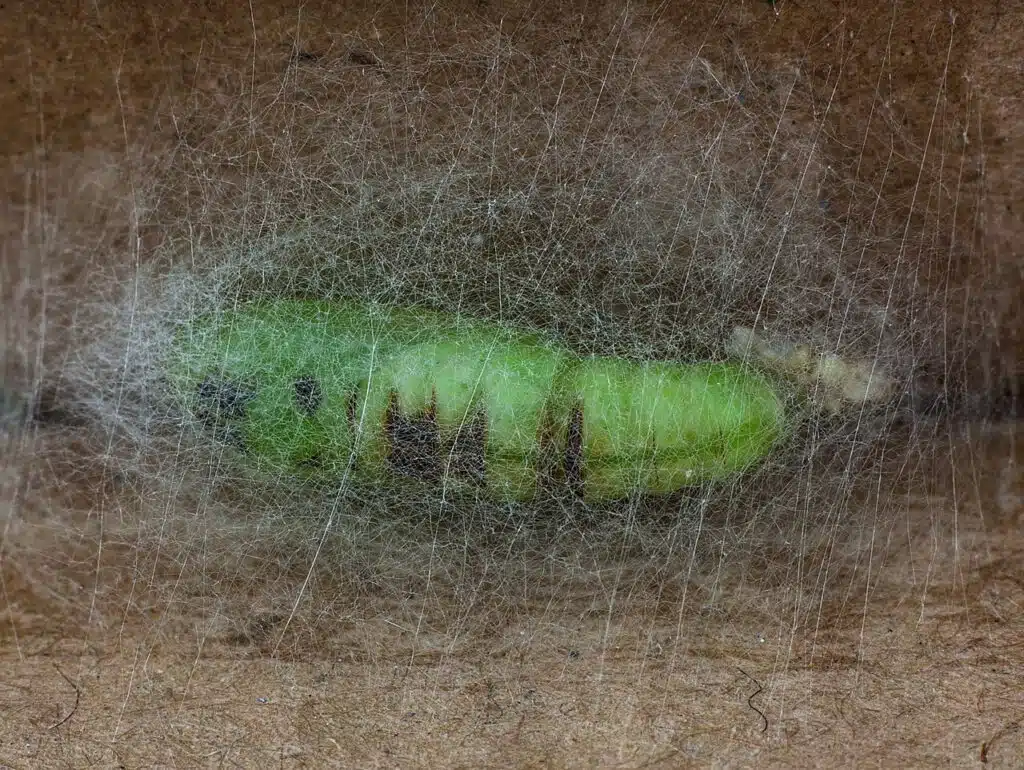
The Cabbage Looper Caterpillar (Trichoplusia ni) is a serious pest to tomatoes, cabbage, broccoli, Brussel sprouts, and cauliflower. They are gray moths with white or silver on the forewings. The caterpillars’ are green and smooth with white lines on the sides and back.
The caterpillar crawls in a loop motion and is present throughout the growing season. The caterpillars attack during all stages of the tomato’s growth and are known to defoliate entire plants. They feed on the underside of the developing leaves.
The outer leaves start sowing small irregular holes. You can often see the green-brown pellets of excrement on the leaf base. The caterpillar will spend the winter in a cocoon on plant debris. Moths emerge in the springtime.
11. Eggplant Fruit And Shoot Borer
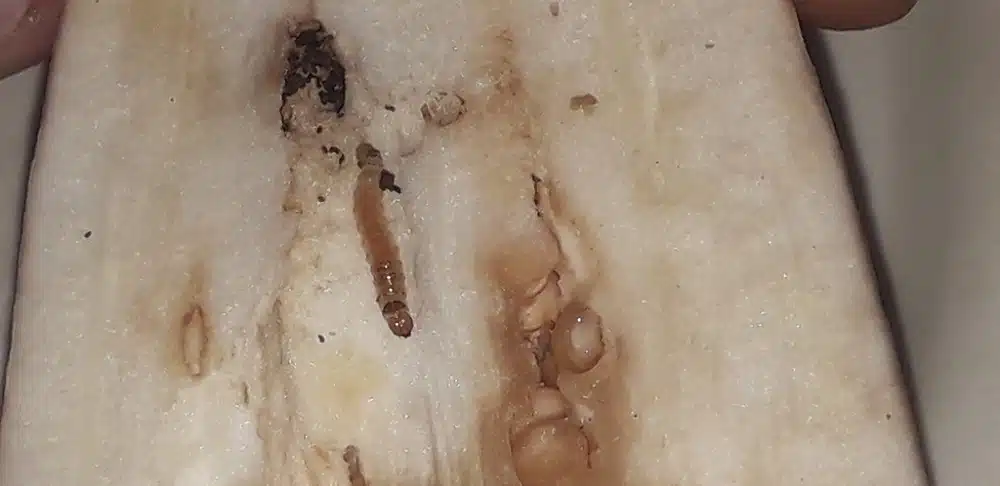
This caterpillar (Leucinodes orbonalis) is a serious threat in South and Southeast Asia. The adult moth flies from fields or debris and deposits eggs on new leaves. The caterpillars emerge and travel a short distance, boring into the new fruits or leaves.
The first sign of an infestation is freshly wilted shoots. These caterpillars will feed on tomatoes and make them impossible to market. They can cause one hundred percent crop losses.
12. Eggplant Webworm
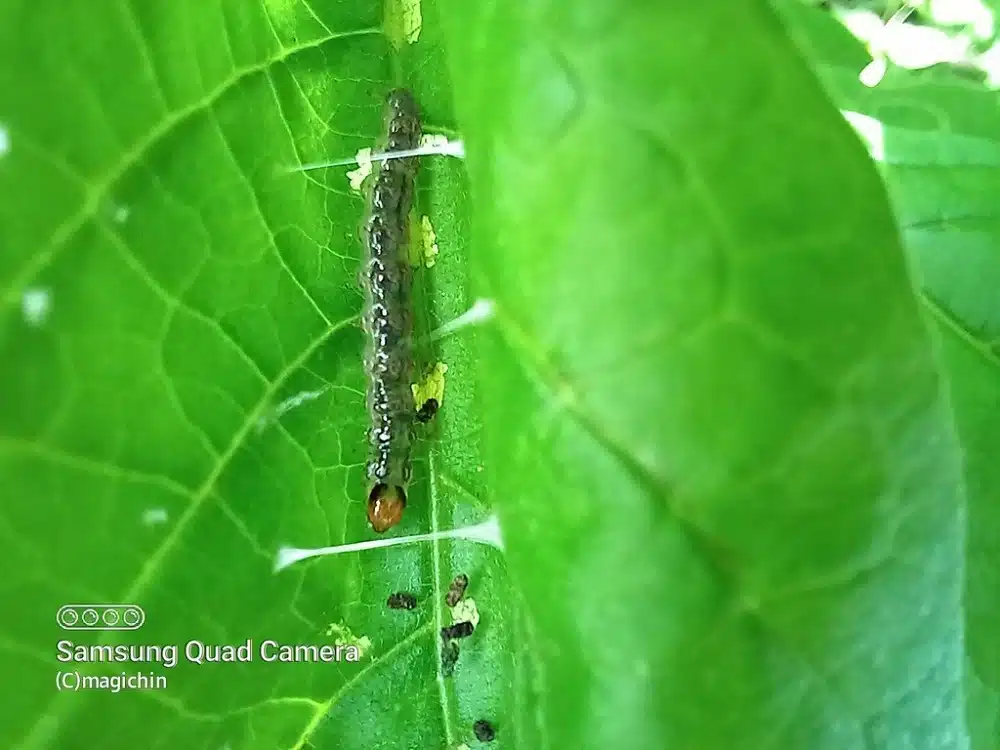
The Eggplant Webworm moth (Rhectocraspeda periusalis) belongs to the Crambidae family and is known to feed on the leaves of the tomato plant. The caterpillars also feed on the tissue close to the midrib of the leaf.
The young caterpillars are yellow, turning dark brown as they age, with two red stripes. They can grow to 20mm in length. Damage is shown as irregular blotches on the leaves.
13. Tobacco Splitworm
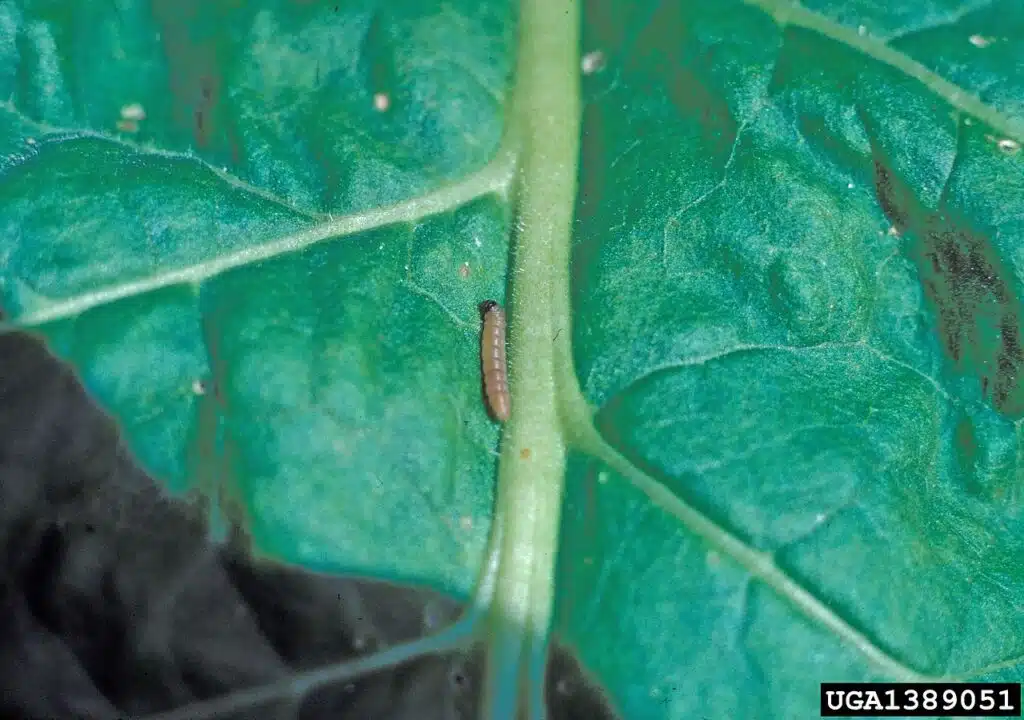
The Tobacco Splitworm (Phthorimaea operculella), known as the potato tuber moth, belongs to the Gelenchidae family. It is a serious pest of potato and tomato crops, growing to 15mm in length.
The caterpillar is yellow or white with a brown head. There are black spots on the thorax, along with bristles. The caterpillars feed on the host plants for around two weeks before entering the pupate stage.
The caterpillars wander around the host plant for a few minutes to determine if they want to feed on the plant or not. They attach silk to the surface as it moves. They will bite a few leaves as they move. Once a location is chosen, they build a silk roof around the area and start eating downwards.
The caterpillar creates a narrow cocoon, only 1.5 inches in length. The cocoon is usually white in color and the adult moth will emerge after around thirty days, depending on the conditions.
14. Tomato Pinworm
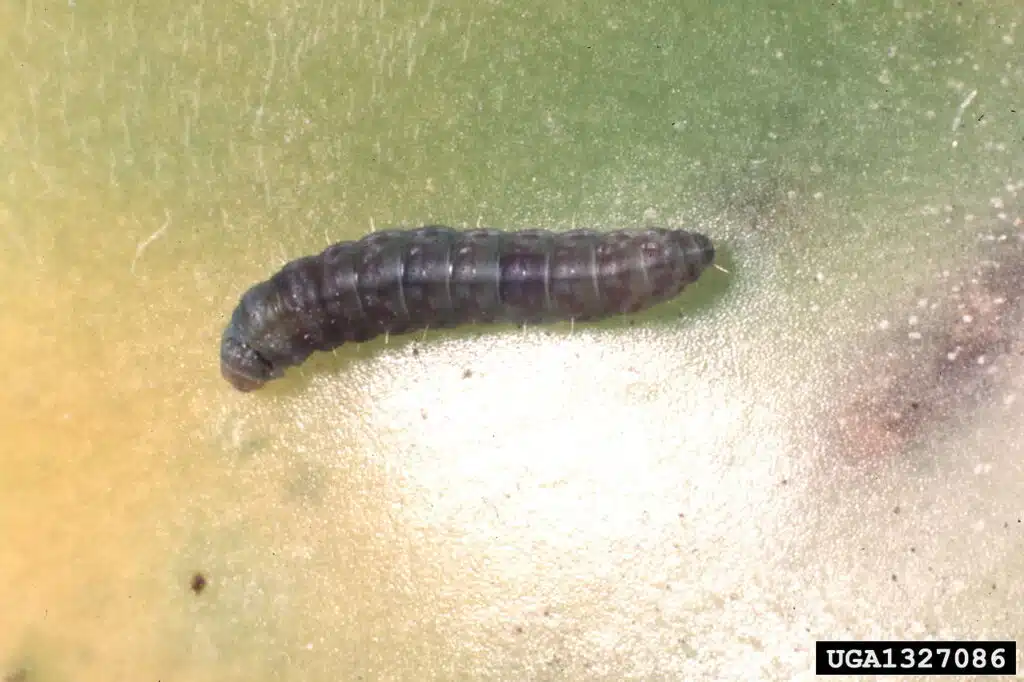
Tomato Pinworms (Keiferia lycopersicella) are small moths. The caterpillars cause serious damage to tomatoes in Mexico and California. The adult female lays eggs in single or groups of two on the tomato plant leaf. The eggs are pale yellow, turning orange just before it hatches.
The young caterpillar spins a silk tent to cover itself and tunnels into the leaf. As they feed you will notice a block-like pattern on the same leaf. As they grow, they feed from inside the leaves, entering the stem and the fruit. Mature caterpillars leave the host plant to form a pupal cell near the soil.
There are up to eight generations per year. The damage they cause to tomatoes is the caterpillar eating the leaves, stems, and fruits. Initially, the damage may appear very slight, but eventually, the plant leaves become infected and the plant dies and the tomato rots. Up to eighty percent of tomato fruits can become infected in one season.
15. Cotton Bollworm
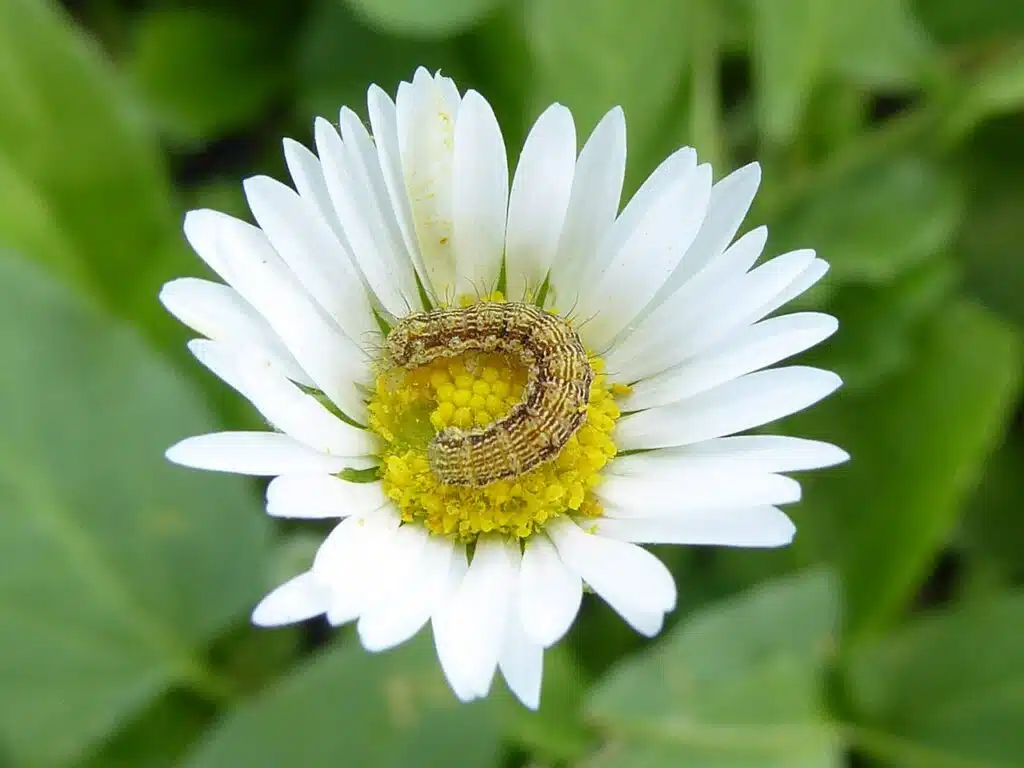
The Cotton Bollworm (Helicoverpa armigera) belongs to the Noctuidae family, also referred to as the cotton earworm. They migrated to the United Kingdom and the caterpillars feed on a variety of plants, including important crops.
The caterpillars vary in size and color. They can grow to 40mm in body length. An adult female can lay several hundred eggs, distributing them over various sections of the host plant. The eggs can hatch within three days in favorable conditions. The eggs are white and turn green just before the caterpillar emerges.
The caterpillars can take twenty-two days before they develop into a moth. They are mostly yellow and green, though some are red-brown. They have yellow heads and three stripes down the back. They are aggressive and will eat each other.
If you disturb the caterpillar, it will drop from the plant and curl up on the ground. They create a silken cocoon, which takes fifteen days in the soil for the moth to emerge.
16. Southern Armyworm
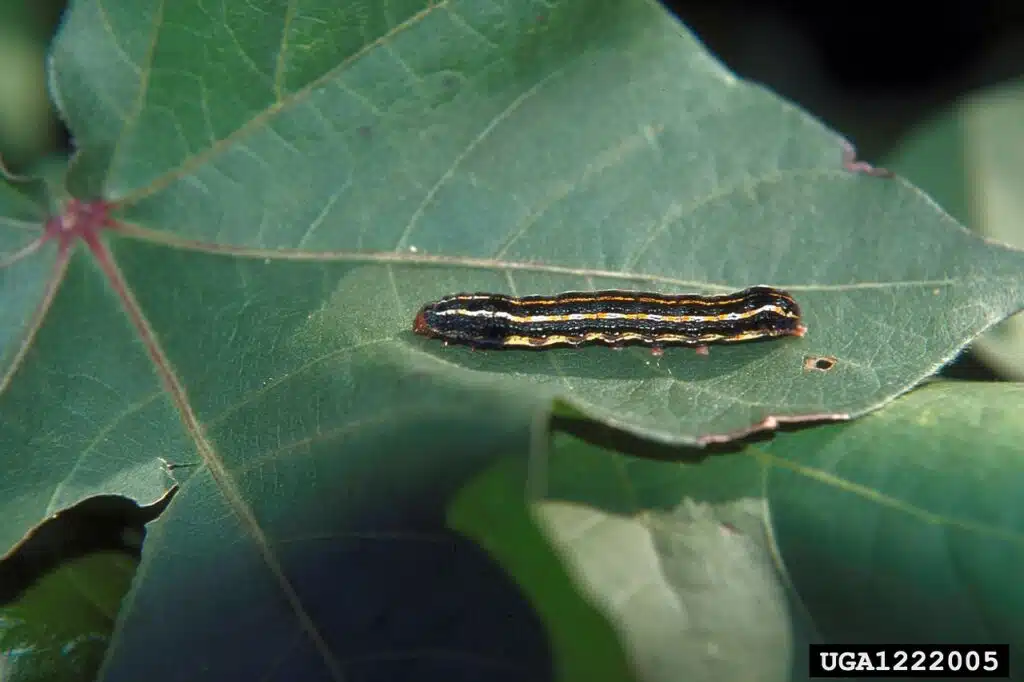
The Southern Armyworm (Spodoptera eridania) is a pest moth and a defoliator in subtropical and tropical regions. They feed on plants while they are still young, leaving skeleton leaves. They are heavy feeders of tomato plants in Florida.
The caterpillar goes through six growth stages, growing to 35mm in length. They are black or green with light brown to red-brown during their development. There is a wide yellow stripe with dark spots on both sides. They have dark triangles along the length of the body.
You will notice the caterpillars at the lower part of the leaves. They are active at night, making them difficult to catch. The six growth stages take around twenty days to complete. The caterpillars pupate in the soil, digging a hole of around ten centimeters. The pupae are brown and around eighteen millimeters in length. The pupal period lasts around thirteen days.
17. Velvet Armyworm
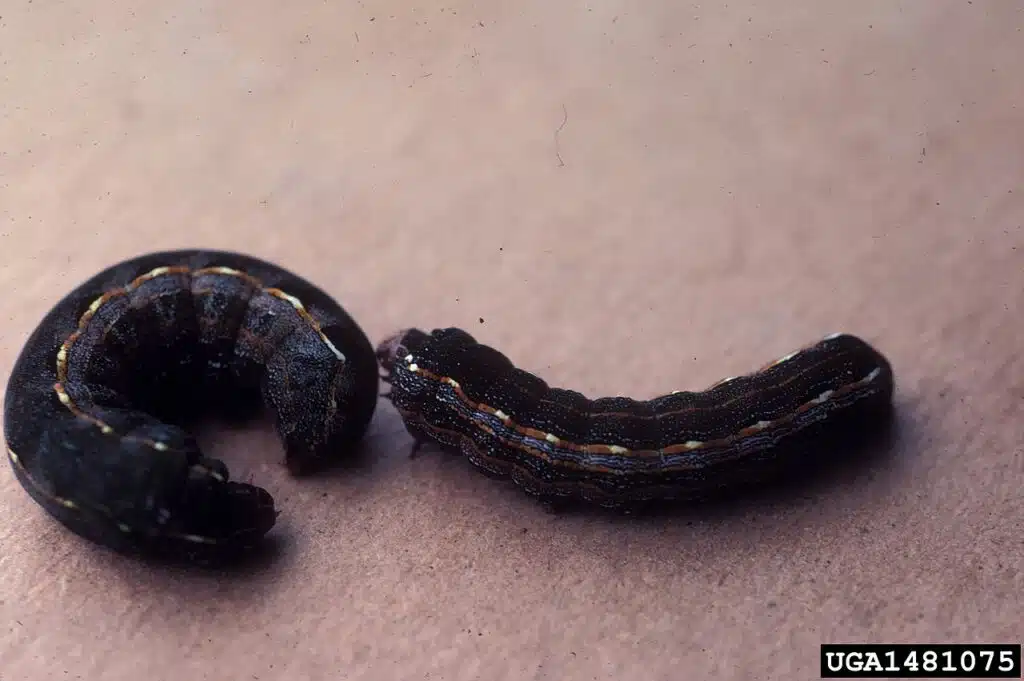
The Velvet Armyworm (Spodoptera latifascia), known as the lateral-lined armyworm or garden armyworm, belongs to the Noctuidae family and is common in Central America and North America. They are a pest species. They are considered serious pests in tropical areas, especially tomatoes and lettuce.
The economic damage caused by these caterpillars is limited to tropical climates. The caterpillars can grow to 43mm in length. The eggs are laid in batches with hundreds of eggs in each batch.
How to Get Rid of Caterpillars on Tomatoes
There are several ways to get rid of caterpillars that are attacking your tomato plants. The sooner you identify them and remove them the better. If left, they can cause serious problems with your tomato crop, damaging the plant and the fruits.
1. Removal by Hand
This is the most time-consuming method to remove caterpillars from your tomato crops, but it is also very effective. It is the most environmentally-friendly way to eradicate them quickly. The caterpillars are not dangerous, but wearing gloves will protect you and make you feel more comfortable as you pick each one up.
You can drop each of the caterpillars into a bucket of soapy water, rather than crushing them. If you cannot see them clearly, spray the plant with water to make them move.
2. Make Your Own Organic Insecticide
Another good option is to make an organic mixture and spray your tomato plants liberally. You can make the mixture by adding two cups of water, some dish soap, and one teaspoon of cayenne pepper.
This deters the caterpillars from feeding. You can add garlic to the mixture, which will reduce the chance of the moths laying eggs on the plant. Ensure you spray both sides of the leaves and stems for it to be effective.
3. Introduce Wasps
Now this one may not be the best idea yet, but it works. Wasps feed on tomato caterpillars, attaching their larvae to the caterpillar. Once attached, the wasp larva feeds on the tomato caterpillar, eventually killing them.
When the caterpillar has wasp larvae attacked, it looks like grains of rice on the back of the caterpillar. You can remove them from your garden, but don’t kill them. The wasps do that for you, enabling the wasps to survive. It also helps you populate your crops with wasps.
4. Introduce Ladybugs
If you are not keen on wasps moving into your garden, consider introducing beautiful and beneficial ladybugs and lacewings. These insects feed on tomato caterpillars, rather than laying eggs on them.
5. Add a Bird Bath or Bird Feeder to Your Garden
You can also consider birds. Birds can spot the caterpillars easily and eat them. Place a bird feeder or bird bath near your tomato plants to encourage the birds, while keeping the caterpillars in easy view.
6. Plant Basil, Marigolds and Dill
Add some basil, marigold, or dill plants with your tomatoes. These plants are effective at keeping pests away, including tomato caterpillars. The tomato worms will enjoy these plants over the tomatoes. They will eat their way through the marigolds, dill, and basil, keeping your tomatoes safe.
The marigolds, basil, and dill also attract beneficial insects which prey on tomato caterpillars. The basil also enhances the flavor of your tomato crops.
7. Use Insecticides
This is not ideal if you want an organic tomato crop. You can apply insecticides to your tomato plants. Each insecticide is different and will give you instructions on how to apply it.
Ensure you read the packaging carefully, especially the warnings and environmental factors. Test a small section on the plant for sensitivity twenty-four hours before using it on the entire plant.
Prevention
Rather than trying to eliminate a tomato caterpillar invasion and the destruction of your tomato crop, you can prevent them from moving onto your tomato plants. This can save you a lot of time and frustration. Taking preventative measures is much easier than curing the situation.
Row Covers
The easiest way to prevent tomato caterpillars in your garden is to eliminate the chance for moths to lay their eggs on your plants. Cover your tomato plants with floating row covers or a high tunnel until they need to be pollinated or removed.
This makes it almost impossible for the moths to get to your plants, so they won’t lay their eggs on the plants. This will eliminate your risk of tomato caterpillars in the easiest possible way.
Diatomaceous Earth
Some professionals say that the diatomaceous earth is very effective at getting rid of hornworms, while others use the earth as a preventative measure. Diatomaceous earth is harmless to humans unless you inhale it.
Diatomaceous earth is a naturally occurring, siliceous, and soft sedimentary rock, that is crumbled into a white powder. It compromises of earth filled with fossilized remains of hard-shelled micro-algae and is often used as a filtration aid. It is also used as the soil in potted bonsai plants and trees.
The diatomaceous earth is harmful to caterpillars, as it is sharp when they crawl over it, causing them to shred their bodies. The caterpillars become dehydrated and over time, they will die.
Black Plastic
You can use black plastic over your tomato plants to stop the moths from emerging in springtime. Doing this breaks the lifecycle of the moth, causing them to die before it lay new eggs on your tomato plants. You can also use a thick layer of cardboard around the plants, which has also proven highly effective.
Inspect
You must inspect your tomato plants regularly for signs of caterpillars. The earlier you catch them the better. If you can identify and eradicate them early on, you can protect your tomatoes, ensuring that they grow to maturity. Don’t ignore the signs of caterpillar damage, as this can ruin your crop, destroying the tomatoes and the plant.